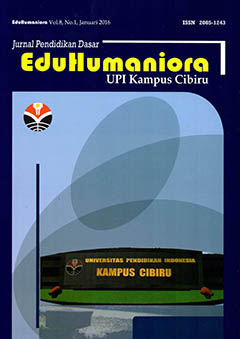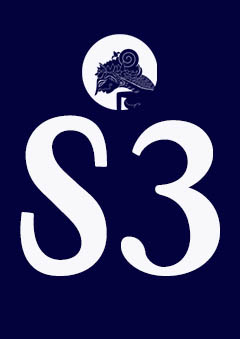Exploring the Influence of Learning Difficulties and Self-Directed Learning on Problem-Solving Ability in Elementary School Students: The Mediating Impact of Mathematical Disposition
Abstract
Keywords
Full Text:
PDFReferences
Aini, H., & Khuzaini, N. (2024). The influence of mathematical disposition on high school students’ understanding of mathematical concepts. Union: Jurnal Ilmiah Pendidikan Matematika, 12(1), Article 1. https://doi.org/10.30738/union.v12i1.17023
Amaliyah, F., Sukestiyarno, Y. L., & Asikin, M. (2021). Mathematical Problem Solving Ability in Self-Directed Learning with Module From Studentsâ€TM Self-Regulated Learning. Unnes Journal of Mathematics Education Research, 10(A), Article A. https://journal.unnes.ac.id/sju/ujmer/article/view/43086
Amidi, Zahrona, S. Z., & Chaniago, A. F. (2021). The influence of self-directed learning on mathematical problem solving ability in problem-based learning with ethnomathematics nuances. Journal of Physics: Conference Series, 1918(4), 042121. https://doi.org/10.1088/1742-6596/1918/4/042121
Apriliani, F. D., Widihastuti, Daryono, R. W., Jaya, D. J., & Rizbudiani, A. D. (2023). The Influence of Fashion Knowledge, Fashion Selection Factor, and Dress Etiquette on Dress Look. Jurnal Pendidikan Dan Pengajaran, 56(1), Article 1. https://doi.org/10.23887/jpp.v56i1.53677
Ardi, Z., Rangka, I. B., Ifdil, I., Suranata, K., Azhar, Z., Daharnis, D., Afdal, A., & Alizamar, A. (2019). Exploring the elementary students learning difficulties risks on mathematics based on students mathematic anxiety, mathematics self-efficacy and value beliefs using rasch measurement. Journal of Physics: Conference Series, 1157(3), 032095. https://doi.org/10.1088/1742-6596/1157/3/032095
Ariani, D. N., Sumantri, M. S., & Wibowo, F. C. (2022). The Impact of Android Module-Based Inquiry Flipped Classroom Learning on Mathematics Problem Solving and Creative Thinking Ability. International Journal of Interactive Mobile Technologies (iJIM), 16(24), Article 24. https://doi.org/10.3991/ijim.v16i24.35749
Athikah, A., Kamid, K., & Haryanto, H. (2023). The Influence of the Application of Discovery Learning and Problem Based Learning Models on Mathematical Creative Thinking Abilities Viewed from the Self-Directed Learning of SMK. PRISMA, 12(2), Article 2. https://doi.org/10.35194/jp.v12i2.3385
Bishara, S. (2021). The cultivation of self-directed learning in teaching mathematics. World Journal on Educational Technology: Current Issues, 13(1), 82–95. https://www.ceeol.com/search/article-detail?id=959516
Dagdag, J. D., & Calimag, N. A. (2023). Scale development and investigation of self-directed learning readiness in Mathematics among Filipino college students. Journal of Research, Policy & Practice of Teachers and Teacher Education, 13(1), Article 1. https://doi.org/10.37134/jrpptte.vol13.1.5.2023
Dagdag, J. D., Palapuz, N. A., & Calimag, N. A. (2021). Predictive ability of problem-solving efficacy sources on mathematics achievement. International Journal of Evaluation and Research in Education (IJERE), 10(4), Article 4. https://doi.org/10.11591/ijere.v10i4.21416
Darwani, D., Abidin, Z., & Hardisa, R. (2023). Description of Procedural Fluency and Productive Mathematical Disposition of Middle School Students. Al Khawarizmi: Jurnal Pendidikan Dan Pembelajaran Matematika, 7(1), Article 1. https://doi.org/10.22373/jppm.v7i1.18877
Daryono, R. W., Hariyanto, V. L., Usman, H., & Sutarto, S. (2020). Factor analysis: Competency framework for measuring student achievements of architectural engineering education in Indonesia. REID (Research and Evaluation in Education), 6(2), Article 2. https://doi.org/10.21831/reid.v6i2.32743
Daryono, R. W., Hidayat, N., Nurtanto, M., & Fu’adi, A. (2024). The development of a competency framework for architectural engineering graduates: Perspectives by the construction industry in Indonesia. Journal of Technology and Science Education, 14(2), Article 2. https://doi.org/10.3926/jotse.1986
Daryono, R. W., Ramadhan, M. A., Kholifah, N., Isnantyo, F. D., & Nurtanto, M. (2023). An empirical study to evaluate the student competency of vocational education. International Journal of Evaluation and Research in Education (IJERE), 12(2), Article 2. https://doi.org/10.11591/ijere.v12i2.22805
Ding, Y., Liu, R.-D., Hong, W., Yu, Q., Wang, J., Liu, Y., & Zhen, R. (2021). Specific Mental Arithmetic Difficulties and General Arithmetic Learning Difficulties: The Role of Phonological Working Memory. Psychological Reports, 124(2), 720–751. https://doi.org/10.1177/0033294120916865
Fauzan, A., Triyono, M. B., Hardiyanta, R. A. P., Daryono, R. W., & Arifah, S. (2023). The Effect of Internship and Work Motivation on Students’ Work Readiness in Vocational Education: PLS-SEM Approach. Journal of Innovation in Educational and Cultural Research, 4(1), Article 1. https://doi.org/10.46843/jiecr.v4i1.413
Gumilang, E. S., Martini, T., & Budiana, D. (2022). Self-regulated learning based-STEM model: How it impacts students’ self-directed learning in physical education classes. Journal Sport Area, 7(3), Article 3. https://doi.org/10.25299/sportarea.2022.vol7(3).10550
Gunawan, M., & Yuspriati, D. N. (2024). Analysis of Mathematical Problem Solving Ability of XI Class Vocational Students on Composition Function Material. (JIML) JOURNAL OF INNOVATIVE MATHEMATICS LEARNING, 7(1), Article 1. https://doi.org/10.22460/jiml.v7i1.19360
Hariyanto, V. L., Daryono, R. W., Hidayat, N., Prayitno, S. H., & Nurtanto, M. (2022). A framework for measuring the level of achievement of vocational students competency of architecture education. Journal of Technology and Science Education, 12(1), Article 1. https://doi.org/10.3926/jotse.1188
Hershcovits, H., Vilenchik, D., & Gal, K. (2020). Modeling Engagement in Self-Directed Learning Systems Using Principal Component Analysis. IEEE Transactions on Learning Technologies, 13(1), 164–171. https://doi.org/10.1109/TLT.2019.2922902
Hidayanthi, R., Fitria, Y., Syarifuddin, H., & Miaz, Y. (2022). Elementary School Students’ Mathematical Disposition Ability Oriented with STEAM Approach. International Journal of Elementary Education, 6(4), Article 4. https://doi.org/10.23887/ijee.v6i4.54086
Katuuk, R. C., Sumarauw, S. J. A., & Pulukadang, R. J. (2024). Problem Solving Ability of Remboken 1 Middle School Students in Solving Story Problems in Algebraic Form Based on Polya’s Steps. Journal of Education Research, 5(1), Article 1. https://doi.org/10.37985/jer.v5i1.691
Man, Y. L., Hidayah, I., & Adhi, N. R. D. N. (2023). The Influence of Self-Directed Learning Assisted by Modules on Mathematical Literacy in Terms of Students’ Learning Independence. Al Khawarizmi: Jurnal Pendidikan Dan Pembelajaran Matematika, 7(2), Article 2. https://doi.org/10.22373/jppm.v7i2.21079
Marisa, R., Santi, Y., Yeni, E. M., & Nirmala, S. D. (2023). DISPOSITION ANALYSIS OF ELEMENTARY SCHOOL STUDENTS IN MATHEMATICAL PROBLEM SOLVING. Primary: Jurnal Pendidikan Guru Sekolah Dasar, 12(1), Article 1. https://doi.org/10.33578/jpfkip.v12i1.9588
Mawardin, M., Adiansha, A. A., Mulyadin, M., & Nurgufriani, A. (2023). Correlation Study: Self-Concept and Mathematical Disposition on Learning Outcomes of Elementary School Students. Journal of Insan Mulia Education, 1(1), Article 1. https://doi.org/10.59923/joinme.v1i1.6
Muhammad, M., Purwanto, J., & Abida, R. (2021). Potential solving mathematical problem students focused on self-directed learning in COVID-19 pandemic. Journal of Physics: Conference Series, 1778(1), 012035. https://doi.org/10.1088/1742-6596/1778/1/012035
Mustafa, D., Mustafa, I. G., Zriqat, S., & AlThebyan, Q. (2022). Smart Assistive 3D Tool to Remedy Children’s Learning Difficulties for Distance Education. 2022 International Arab Conference on Information Technology (ACIT), 1–5. https://doi.org/10.1109/ACIT57182.2022.9994172
Nurlina, A., Hendriana, H., Fitrianna, A. Y., & Afrilianto, M. (2024). Implementation of Scientific Approach to Increasing Junior High School Students’ Mathematical Problem Solving Ability. (JIML) JOURNAL OF INNOVATIVE MATHEMATICS LEARNING, 7(1), Article 1. https://doi.org/10.22460/jiml.v7i1.18777
Nurrahmah, A., Agustina, L., & Nurhayati, N. (2021). Students Abstract Thinking Abilities in terms of Mathematical Disposition. Al-Jabar : Jurnal Pendidikan Matematika, 12(1), Article 1. https://doi.org/10.24042/ajpm.v12i1.8652
Pokhrel, M., Sharma, L., Poudel, M. P., Sharma, L., & Luitel, S. (2024). Empowering Students through a Self-Directed Learning Pedagogy in Mathematics Education. Communications on Applied Nonlinear Analysis, 31(1), Article 1. https://doi.org/10.52783/cana.v31.409
Purnawan, D. (2022). Analysis and Methods of Overcoming Mathematics Learning Difficulties in Elementary School Students: Literature Review. Social, Humanities, and Educational Studies (SHES): Conference Series, 4(5), Article 5. https://doi.org/10.20961/shes.v4i5.66201
Putra, K. A. J., Triyono, M. B., & Daryono, R. W. (2022). The Influence of Entrepreneurship Competency and Leadership Challenge to Principals’ Leadership Solutions. Jurnal Pendidikan Dan Pengajaran, 55(2), Article 2. https://doi.org/10.23887/jpp.v55i2.43711
Safitri, M., Suryani, N., Asrowi, & Sukarmin. (2024). Validity of Metacognitive Awareness Inventory as A Measuring Tool for Metacognitive Ability in Mathematics Problem Solving. Journal of Law and Sustainable Development, 12(1), e2246–e2246. https://doi.org/10.55908/sdgs.v12i1.2246
Saputra, H. (2022). The Effect of Using Geogebra Assisted STAD Type Learning Model on Problem Solving Ability and Mathematical Disposition. Al-Madrasah: Jurnal Ilmiah Pendidikan Madrasah Ibtidaiyah, 6(3), Article 3. https://doi.org/10.35931/am.v6i3.1028
Setiawan, Y. E., & Surahmat. (2023). The Effect of Mathematical Disposition on Basic Mathematical Abilities in the Online Learning. Journal of Education Research and Evaluation, 7(2), Article 2. https://doi.org/10.23887/jere.v7i2.58437
Shanta, S., & Wells, J. G. (2022). T/E design based learning: Assessing student critical thinking and problem solving abilities. International Journal of Technology and Design Education, 32(1), 267–285. https://doi.org/10.1007/s10798-020-09608-8
Sholihah, N., Iklimatunnajah, I., Hartanti, F. D., & Pitriyani, P. (2023). Identification of Student Learning Difficulties Based on Self, Environment, and Family Aspects in Learning Mathematics at the Elementary School Level. Educational Insights, 1(1), Article 1. https://eduinsights.id/index.php/eduinsights/article/view/2
Simbolon, A., Mangiri, G. R. P., & Dasari, D. (2024). The Influence of the Anchored Instruction (AI) Model on Students’ Mathematical Problem Solving Ability. Jurnal Padegogik, 7(1), Article 1. https://doi.org/10.35974/jpd.v7i1.3266
Sukardjo, M., & Salam, M. (2020). Effect of Concept Attainment Models and Self-Directed Learning (SDL) on Mathematics Learning Outcomes. International Journal of Instruction, 13(3), 275–292. https://eric.ed.gov/?id=EJ1259428
Sulistyani, D., Subekti, E. E., & Wardana, M. Y. S. (2021). Students’ Learning Difficulties Review from Mathematics Problem-Solving Ability in Third-Grade Elementary School. Indonesian Journal of Educational Research and Review, 4(2), Article 2. https://doi.org/10.23887/ijerr.v4i2.30310
Supriyanto, S., Munadi, S., Daryono, R. W., Tuah, Y. A. E., Nurtanto, M., & Arifah, S. (2022). The Influence of Internship Experience and Work Motivation on Work Readiness in Vocational Students: PLS-SEM Analysis. Indonesian Journal on Learning and Advanced Education (IJOLAE), 5(1), Article 1. https://doi.org/10.23917/ijolae.v5i1.20033
Suratman, S. (2023). Building Madrasah Committee Synergy in Managing Effective and Resilient Skills Programs. Al-Tanzim: Jurnal Manajemen Pendidikan Islam, 7(1), Article 1. https://doi.org/10.33650/al-tanzim.v7i1.4614
Thompson, P. W., & Harel, G. (2021). Ideas foundational to calculus learning and their links to students’ difficulties. ZDM – Mathematics Education, 53(3), 507–519. https://doi.org/10.1007/s11858-021-01270-1
Tiara, T., Sukestiyarno, Y. L., & Mulyono, M. (2024). The Mathematical Problem-Solving Ability through the Search, Solve, Create and Share (SSCS) Learning Model. Edunesia : Jurnal Ilmiah Pendidikan, 5(1), Article 1. https://doi.org/10.51276/edu.v5i1.720
Ulya, H., & Rahayu, R. (2021). Mathematical Disposition of Students in Open-Ended Learning Based on Ethnomathematics. Journal of Education Technology, 5(3), Article 3. https://doi.org/10.23887/jet.v5i3.33535
Widayanto, L. D., Soeharto, S., Sudira, P., Daryono, R. W., & Nurtanto, M. (2021). Implementation of the Education and Training Program seen from the CIPPO Perspective. Journal of Education Research and Evaluation, 5(4), Article 4. https://doi.org/10.23887/jere.v5i4.36826
Widyastuti, P., Hadi, S., Daryono, R. W., & Samad, N. B. A. (2023). The Mediation Role of University Environment in the Relationship between Self-Efficacy and Family Environment on Entrepreneurial Education Interest: A PLS-SEM Approach. Indonesian Journal on Learning and Advanced Education (IJOLAE), 5(3), Article 3. https://doi.org/10.23917/ijolae.v5i3.22015
Woodcock, S., & Moore, B. (2021). Inclusion and students with specific learning difficulties: The double-edged sword of stigma and teacher attributions. Educational Psychology, 41(3), 338–357. https://doi.org/10.1080/01443410.2018.1536257
Zhou, D., Du, X., Hau, K.-T., Luo, H., Feng, P., & Liu, J. (2020). Teacher-student relationship and mathematical problem-solving ability: Mediating roles of self-efficacy and mathematical anxiety. Educational Psychology, 40(4), 473–489. https://doi.org/10.1080/01443410.2019.1696947
Zulaiha, S. (2021). The effect of geogebra-aided problem based instruction model and mathematical disposition on problem solving ability. International Journal of Learning and Instruction (IJLI), 3(1), 40–44. https://doi.org/10.26418/ijli.v3i1.44657
DOI: https://doi.org/10.17509/eh.v16i2.69346
Refbacks
- There are currently no refbacks.
Copyright (c) 2024 EduHumaniora | Jurnal Pendidikan Dasar Kampus Cibiru
EduHumaniora: Jurnal Pendidikan Dasar
Published in collaboration Program Studi PGSD UPI Kampus Cibiru
and
HDPGSDI
This work is licensed under a Creative Commons Attribution-ShareAlike 4.0 International License.















